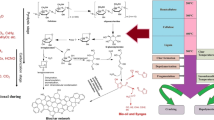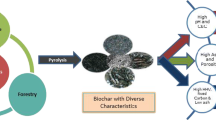Abstract
This work investigated the influence of pretreatment methods (using sulfuric acid, sodium hydroxide, or calcium hydroxide) on the characteristics of biochar prepared from residues generated by lignocellulosic ethanol production. As a result, the biochar prepared from the residue of an acid pretreatment-based process showed better thermal stability than the other two biochars. The weight loss rates of three kinds of biochar at 900 °C were 17.85%, 30.95%, and 36.76%. The specific surface areas of the three biochars were 3.03 m2/g, 1.24 m2/g, and 8.04 m2/g, respectively, with the largest specific surface area found on the biochar of calcium hydroxide pretreatment-based process. FTIR analysis showed that the types of surface functional groups of the biochars were basically the same. The maximum theoretical adsorption capacities of the three biochars for methylene blue were 37.3 mg/g, 48.7 mg/g, and 58.2 mg/g, respectively. The adsorption capacity of biochar from alkali pretreatment for methylene blue was significantly better than that from acid pretreatment. The overall results showed that the properties of biochars prepared from fermentation residues under different pretreatment methods were quite different.






Similar content being viewed by others
Data availability
Not applicable.
References
Yek PNY, Cheng YW, Liew RK, Wan Mahari WA, Ong HC, Chen W-H, Peng W, Park Y-K, Sonne C, Kong SH, Tabatabaei M, Aghbashlo M, Lam SS (2021) Progress in the torrefaction technology for upgrading oil palm wastes to energy-dense biochar: a review. Renew Sust Energ Rev 151:111645. https://doi.org/10.1016/j.rser.2021.111645
Gazal AA, Jakrawatana N, Silalertruksa T, Gheewala SH (2022) Water-energy-land-food nexus for bioethanol development in Nigeria. Biomass Convers Bior. https://doi.org/10.1007/s13399-022-02528-8
Lu X, Zhu X, Guo H, Que H, Wang D, Liang D, He T, Hu C, Xu C, Gu X (2020) Efficient depolymerization of alkaline lignin to phenolic compounds at low temperatures with formic acid over inexpensive Fe–Zn/Al2O3 Catalyst. Energ Fuel 34(6):7121–7130. https://doi.org/10.1021/acs.energyfuels.0c00742
Byun J, Cha Y-L, Park S-M, Kim K-S, Lee J-E, Kang Y-G (2020) Lignocellulose pretreatment combining continuous alkaline single-screw extrusion and ultrasonication to enhance biosugar production. Energies 13(21):5636. https://doi.org/10.3390/en13215636
Pang B, Cao X-F, Sun S-N, Wang X-L, Wen J-L, Lam SS, Yuan T-Q, Sun R-C (2020) The direct transformation of bioethanol fermentation residues for production of high-quality resins. Green Chem 22(2):439–447. https://doi.org/10.1039/C9GC03568K
Biswas B, Singh R, Kumar J, Khan AA, Krishna BB, Bhaskar T (2016) Slow pyrolysis of prot, alkali and dealkaline lignins for production of chemicals. Bioresource Technol 213:319–326. https://doi.org/10.1016/j.biortech.2016.01.131
Asuha S, Fei F, Wurendaodi W, Zhao S, Wu H, Zhuang X (2020) Activation of kaolinite by a low-temperature chemical method and its effect on methylene blue adsorption. Powder Technol 361:624–632. https://doi.org/10.1016/j.powtec.2019.11.068
Rambabu K, Bharath G, Monash P, Velu S, Banat F, Naushad M, Arthanareeswaran G, Loke Show P (2019) Effective treatment of dye polluted wastewater using nanoporous CaCl2 modified polyethersulfone membrane. Process Saf Environ 124:266–278. https://doi.org/10.1016/j.psep.2019.02.015
Vadivel S, Theerthagiri J, Madhavan J, SanthoshiniPriya T, Balasubramanian N (2016) Enhanced photocatalytic activity of degradation of azo, phenolic and triphenyl methane dyes using novel octagon shaped BiOCl discs/MWCNT composite. J Water Process Eng 10:165–171. https://doi.org/10.1016/j.jwpe.2015.12.001
Yang X, Jin D, Zhang M, Wu P, Jin H, Li J, Wang X, Ge H, Wang Z, Lou H (2016) Fabrication and application of magnetic starch-based activated hierarchical porous carbon spheres for the efficient removal of dyes from water. Mater Chem Phys 174:179–186. https://doi.org/10.1016/j.matchemphys.2016.02.073
Zheng Y, Yao G, Cheng Q, Yu S, Liu M, Gao C (2013) Positively charged thin-film composite hollow fiber nanofiltration membrane for the removal of cationic dyes through submerged filtration. Desalination 328:42–50. https://doi.org/10.1016/j.desal.2013.08.009
Shah BA, Oluyinka OA, Shah AV (2019) Fly ash reuse as mesoporous Ca- and Mg-zeolitic composites for the seclusion of aniline from aqueous solution. Arab J Sci Eng 44(1):289–304. https://doi.org/10.1007/s13369-018-3596-1
Nithyalakshmi B, Saraswathi R (2021) Removal of colorants from wastewater using biochar derived from leaf waste. Biomass Convers Bior. https://doi.org/10.1007/s13399-021-01776-4
Mouni L, Belkhiri L, Bollinger J-C, Bouzaza A, Assadi A, Tirri A, Dahmoune F, Madani K, Remini H (2018) Removal of methylene blue from aqueous solutions by adsorption on kaolin: kinetic and equilibrium studies. Appl Clay Sci 153:38–45. https://doi.org/10.1016/j.clay.2017.11.034
Wang Y, Pan J, Li Y, Zhang P, Li M, Zheng H, Zhang X, Li H, Du Q (2020) Methylene blue adsorption by activated carbon, nickel alginate/activated carbon aerogel, and nickel alginate/graphene oxide aerogel: a comparison study. J Mater Res Technol 9(6):12443–12460. https://doi.org/10.1016/j.jmrt.2020.08.084
Oluyinka OA, Patel AV, Shah BA, Bagia MI (2020) Microwave and fusion techniques for the synthesis of mesoporous zeolitic composite adsorbents from bagasse fly ash: sorption of p-nitroaniline and nitrobenzene. Appl Water Sci 10(12):236. https://doi.org/10.1007/s13201-020-01327-8
Chen B, Yang Z, Ma G, Kong D, Xiong W, Wang J, Zhu Y, Xia Y (2018) Heteroatom-doped porous carbons with enhanced carbon dioxide uptake and excellent methylene blue adsorption capacities. Micropor Mesopor Mat 257:1–8. https://doi.org/10.1016/j.micromeso.2017.08.026
Panwar NL, Pawar A (2020) Influence of activation conditions on the physicochemical properties of activated biochar: a review. Biomass Convers Bior 12(3):925–947. https://doi.org/10.1007/s13399-020-00870-3
Chen B, Chen Z, Lv S (2011) A novel magnetic biochar efficiently sorbs organic pollutants and phosphate. Bioresource Technol 102(2):716–723. https://doi.org/10.1016/j.biortech.2010.08.067
Ren T, Chen N, Wan Mahari WA, Xu C, Feng H, Ji X, Yin Q, Chen P, Zhu S, Liu H, Liu G, Li L, Lam SS (2021) Biochar for cadmium pollution mitigation and stress resistance in tobacco growth. Environ Res 192:110273. https://doi.org/10.1016/j.envres.2020.110273
Yi Y, Huang Z, Lu B, Xian J, Tsang EP, Cheng W, Fang J, Fang Z (2020) Magnetic biochar for environmental remediation: a review. Bioresource Technol 298:122468. https://doi.org/10.1016/j.biortech.2019.122468
Hu B, Ai Y, Jin J, Hayat T, Alsaedi A, Zhuang L, Wang X (2020) Efficient elimination of organic and inorganic pollutants by biochar and biochar-based materials. Biochar 2(1):47–64. https://doi.org/10.1007/s42773-020-00044-4
Wan Mahari WA, Waiho K, Azwar E, Fazhan H, Peng W, Ishak SD, Tabatabaei M, Yek PNY, Almomani F, Aghbashlo M, Lam SS (2022) A state-of-the-art review on producing engineered biochar from shellfish waste and its application in aquaculture wastewater treatment. Chemosphere 288:132559. https://doi.org/10.1016/j.chemosphere.2021.132559
Liu S, W-h Xu, Liu Y-g, Tan X-f, G-m Zeng X, Li JL, Zhou Z, Yan Z-l, Cai X-x (2017) Facile synthesis of Cu(II) impregnated biochar with enhanced adsorption activity for the removal of doxycycline hydrochloride from water. Sci Total Environ 592:546–553. https://doi.org/10.1016/j.scitotenv.2017.03.087
Ghodake GS, Shinde SK, Kadam AA, Saratale RG, Saratale GD, Kumar M, Palem RR, Al-Shwaiman HA, Elgorban AM, Syed A, Kim D-Y (2021) Review on biomass feedstocks, pyrolysis mechanism and physicochemical properties of biochar: state-of-the-art framework to speed up vision of circular bioeconomy. J Clean Prod 297:126645. https://doi.org/10.1016/j.jclepro.2021.126645
Chen XX, Yuan XCA, Chen ST, Yu JM, Zhai R, Xu ZX, Jin MJ (2021) Densifying lignocellulosic biomass with alkaline chemicals (DLC) pretreatment unlocks highly fermentable sugars for bioethanol production from corn stover. Green Chem 23(13):4828–4839. https://doi.org/10.1039/D1GC01362A
Yuan XC, Shen GN, Chen ST, Chen XX, Zhang CC, Liu SM, Jin MJ (2022) Modified simultaneous saccharification and co-fermentation of DLC pretreated corn stover for high-titer cellulosic ethanol production without water washing or detoxifying pretreated biomass. Energy 247. https://doi.org/10.1016/j.energy.2022.123488
Sluiter JB, Ruiz RO, Scarlata CJ, Sluiter AD, Templeton DW (2010) Compositional analysis of lignocellulosic feedstocks. 1. Review and description of methods. J Agr Food Chem 58(16):9043–9053. https://doi.org/10.1021/jf1008023
Oluyinka OA, Oke EA, Oyelude EO, Abugri J, Raheem SA (2022) Recapitulating potential environmental and industrial applications of biomass wastes. J Mater Cycles Waste 24(6):2089–2107. https://doi.org/10.1007/s10163-022-01473-y
Kim H-B, Kim J-G, Kim T, Alessi DS, Baek K (2020) Mobility of arsenic in soil amended with biochar derived from biomass with different lignin contents: relationships between lignin content and dissolved organic matter leaching. Chem Eng J 393:124687. https://doi.org/10.1016/j.cej.2020.124687
Wan J, Liu L, Ayub KS, Zhang W, Shen G, Hu S, Qian X (2020) Characterization and adsorption performance of biochars derived from three key biomass constituents. Fuel 269:117142. https://doi.org/10.1016/j.fuel.2020.117142
Xu Y, Bai T, Yan Y, Ma K (2020) Influence of sodium hydroxide addition on characteristics and environmental risk of heavy metals in biochars derived from swine manure. Waste Manage 105:511–519. https://doi.org/10.1016/j.wasman.2020.02.035
Liu L, Yue T, Liu R, Lin H, Wang D, Li B (2021) Efficient absorptive removal of Cd(II) in aqueous solution by biochar derived from sewage sludge and calcium sulfate. Bioresource Technol 336:125333. https://doi.org/10.1016/j.biortech.2021.125333
Meng F, Wang D, Zhang M (2021) Effects of different pretreatment methods on biochar properties from pyrolysis of corn stover. J Energy Inst 98:294–302. https://doi.org/10.1016/j.joei.2021.07.008
Yu L, Gamliel DP, Markunas B, Valla JA (2021) A promising solution for food waste: preparing activated carbons for phenol removal from water streams. ACS Omega 6(13):8870–8883. https://doi.org/10.1021/acsomega.0c06029
Liu L, Li Y, Fan SS (2019) Preparation of KOH and H3PO4 modified biochar and its application in methylene blue removal from aqueous solution. Processes 7(12). https://doi.org/10.3390/pr7120891
Iqbal J, Shah NS, Sayed M, Niazi NK, Imran M, Khan JA, Khan ZUH, Hussien AGS, Polychronopoulou K, Howari F (2021) Nano-zerovalent manganese/biochar composite for the adsorptive and oxidative removal of Congo-red dye from aqueous solutions. J Hazard Mater 403:123854. https://doi.org/10.1016/j.jhazmat.2020.123854
Liu XJ, Li MF, Singh SK (2021) Manganese-modified lignin biochar as adsorbent for removal of methylene blue. J Mater Res Technol 12:1434–1445. https://doi.org/10.1016/j.jmrt.2021.03.076
Acknowledgements
This work was supported by the “National Key R&D Program of China” (Nos. 2021YFC2101301 & 2016YFE0105400).
Funding
This work was supported by the “National Key R&D Program of China” (Nos. 2021YFC2101301 & 2016YFE0105400).
Author information
Authors and Affiliations
Contributions
Chengcheng Zhang: Designed and performed the experiments, data analysis, and manuscript preparation. Shuangmei Liu: Data analysis. Sitong Chen: Provided engineered yeast and performed the experimental work. Xingchuan Yuan: Data analysis. Xiangxue Chen: Data analysis. Mingjie Jin: Project management, supervision, data analysis, and manuscript preparation.
Corresponding author
Ethics declarations
Ethical approval
Not applicable.
Competing interests
The authors declare no competing interests.
Additional information
Publisher's note
Springer Nature remains neutral with regard to jurisdictional claims in published maps and institutional affiliations.
Supplementary Information
Below is the link to the electronic supplementary material.
Rights and permissions
Springer Nature or its licensor (e.g. a society or other partner) holds exclusive rights to this article under a publishing agreement with the author(s) or other rightsholder(s); author self-archiving of the accepted manuscript version of this article is solely governed by the terms of such publishing agreement and applicable law.
About this article
Cite this article
Zhang, C., Liu, S., Chen, S. et al. Biomass pretreatment method affects the physicochemical properties of biochar prepared from residues of lignocellulosic ethanol production. Biomass Conv. Bioref. (2023). https://doi.org/10.1007/s13399-023-03908-4
Received:
Revised:
Accepted:
Published:
DOI: https://doi.org/10.1007/s13399-023-03908-4




